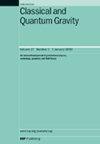Towards robust gravitational wave detections from individual supermassive black hole binaries
IF 3.7
3区 物理与天体物理
Q2 ASTRONOMY & ASTROPHYSICS
引用次数: 0
Abstract
The recent discovery of the stochastic gravitational-wave background via pulsar timing arrays will likely be followed by the detection of individual black hole binaries that stand out above the background. However, to confidently claim the detection of an individual binary, we need not only more and better data, but also more sophisticated analysis techniques. In this paper, we develop two new approaches that can help us more robustly ascertain if a candidate found by a search algorithm is indeed an individual supermassive black hole binary. One of these is a coherence test that directly compares the full signal model to an incoherent version of that. The other is a model scrambling approach that builds null distributions of our detection statistic and compares that with the measured value to quantify our confidence in signal coherence. Both of these rely on finding the coherence between pulsars characteristic to gravitational waves (GWs) from a binary system. We test these methods on simple simulated datasets and find that they work well in correctly identifying both true GWs and false positives. However, as expected for such a flexible and simple signal model, confidently identifying signal coherence is significantly harder than simply finding a candidate in most scenarios. Our analyses also indicate that the confidence with which we can identify a true signal depends not only on the signal-to-noise ratio, but also on the number of contributing pulsars and the amount of frequency evolution shown by the signal.对单个超大质量黑洞双星的强大引力波探测
最近通过脉冲星定时阵列发现了随机引力波背景,之后可能会发现在背景上方突出的单个黑洞双星。然而,要自信地声称检测到单个二进制,我们不仅需要更多更好的数据,还需要更复杂的分析技术。在本文中,我们开发了两种新的方法,可以帮助我们更可靠地确定搜索算法发现的候选黑洞是否确实是单个超大质量黑洞双子星。其中之一是相干性测试,直接将完整信号模型与非相干版本进行比较。另一种是模型置乱方法,它建立检测统计量的零分布,并将其与测量值进行比较,以量化我们对信号相干性的置信度。这两种方法都依赖于找到来自双星系统的脉冲星特征与引力波(GWs)之间的一致性。我们在简单的模拟数据集上测试了这些方法,发现它们在正确识别真GWs和假阳性方面都能很好地工作。然而,正如预期的那样,对于这样一个灵活而简单的信号模型,在大多数情况下,自信地识别信号相干性比简单地找到候选信号要困难得多。我们的分析还表明,我们识别真实信号的信心不仅取决于信噪比,还取决于贡献脉冲星的数量和信号所显示的频率演变量。
本文章由计算机程序翻译,如有差异,请以英文原文为准。
求助全文
约1分钟内获得全文
求助全文
来源期刊

Classical and Quantum Gravity
物理-天文与天体物理
CiteScore
7.00
自引率
8.60%
发文量
301
审稿时长
2-4 weeks
期刊介绍:
Classical and Quantum Gravity is an established journal for physicists, mathematicians and cosmologists in the fields of gravitation and the theory of spacetime. The journal is now the acknowledged world leader in classical relativity and all areas of quantum gravity.
 求助内容:
求助内容: 应助结果提醒方式:
应助结果提醒方式:


